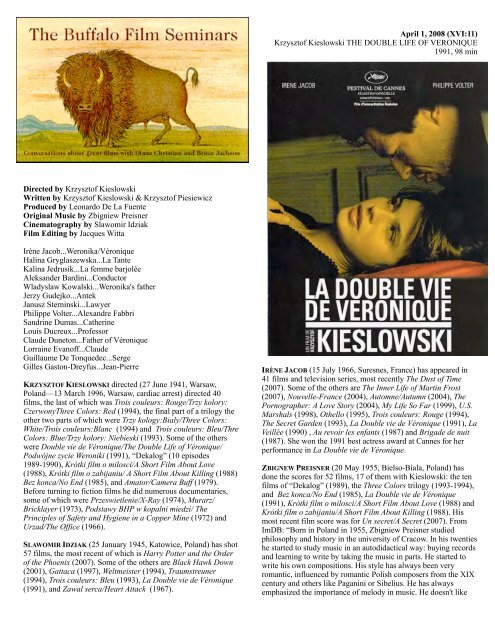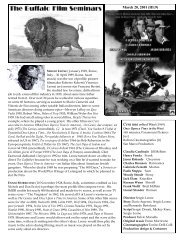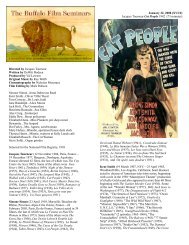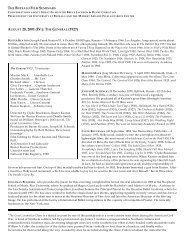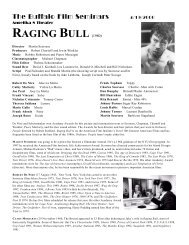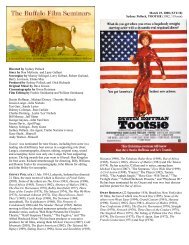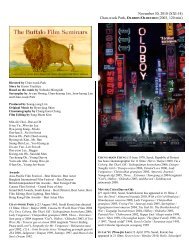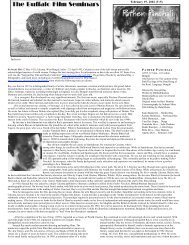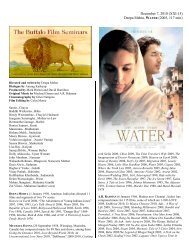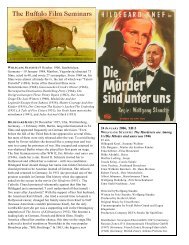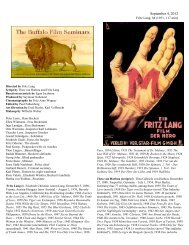Directed by Krzysztof Kieslowski Written by Krzysztof Kieslowski ...
Directed by Krzysztof Kieslowski Written by Krzysztof Kieslowski ...
Directed by Krzysztof Kieslowski Written by Krzysztof Kieslowski ...
You also want an ePaper? Increase the reach of your titles
YUMPU automatically turns print PDFs into web optimized ePapers that Google loves.
<strong>Kieslowski</strong>—THE DOUBLE LIFE OF Véronique—4immediately that day and sign it. He thought, “We’re all in thesame trade, after all, so they’re bound to keep their verbalagreement”; whereas nobody stuck to any verbal agreement, andAndie was offered a film from big studio. she immediatelyaccepted, or her agent immediately accepted, because it was anAmerican film and she’s American; it’s her world, her kind ofmoney, her life, and it seemed obvious to me that she shouldaccept. The producer wrung his hands and cried, because he’s ofItalian descent and is, therefore, allowed to cry. But, on the whole,I was pleased that things turned out the way they did. I waspleased because I’d realized, <strong>by</strong> that time, that I shouldn’t have anAmerican play a French role. I don’t think it would have beenright. I think the French would have been furious and rightly so.They’d say, “what? Don’t we have any French actresses that anAmerican has to play a Frenchwoman? What’s all this about?Have we got a desert in this country?” They’ve got a very strongsense of nationality, like the English, in fact. In this respect, thenations aren’t any different; each regards the others as a bunch ofidiots, more or less to the same degree. Then I just started lookingfor an actress, in the usual way, with screen tests and so on.I decided on the leading role. It would be Irene Jacob;she was twenty-four but looked even younger. She’s not tall and isslim. She was born and brought up in Switzerland, which I like, sothat was a good sign for me. I asked experts what her French waslike. “If she plays a girl from the provinces, she’ll be all right,” theexperts said. She had played in small, short films; films made fora pittance, on a grant or something. She had also played a minorrole in a very beautiful film, which I still love, Au revoir lesenfants, <strong>by</strong> Louis Malle—that was the role I remembered herfrom. That’s why I invited her for a screen test.Andie MacDowell was thirty when we started Véronique,and Irene Jacob was twenty-four. I was afraid she’d be too young,but then it turned out she wasn’t. I always thought this should be ayoung woman, while Irene is still a girl, really—at least in thisfilm she’s a girl. Later when it all started to fall into place, Irealized that it’s a film about a girl and not a young woman.The male lead in The Double Life of Véronique was to beplayed <strong>by</strong> the Italian director Nanni Morettti. I like him and hisfilms very much. He’s masculine yet very delicate. He’s not anactor and only plays leading roles in his own films. But here,strangely enough, he agreed very willingly. I met him long beforeshooting started, and I think we had a good meeting. we arrangedthe dates and the kind of jacket he was to wear in the film, which,incidentally, was his own jacket. We talked about more importantthings too. But then I got bad news from Paris. Nanni couldn’t dothe film. He was ill. He’d be replaced <strong>by</strong> Philippe Volter, a Frenchactor whom I’d liked in Gerard Corbiau’s The Music Teacher. Itwas very good of him, considering that I wanted Moretti. ...When we were looking for a profession for our heroine, aprofession, passion, or whatever—a world for her—weremembered Decalogue 9 and the girl who appeared on the screenfor half a minute or a minute. It’s a shame she was only there forsuch a short time, because it was a fine role, a fine character ingeneral. But there wasn’t any reason for her to appear any longerbecause the film was about something else. So she only appearedas a sort of window, as a contingency for the main character. Butsince we’d already invented the character, she already existed, andit was easy to transfer her desire to do something, her desire tosing. She’s conditioned <strong>by</strong> her illness because sickness setslimitations on her and she cant do what she really wants, althoughhypothetically she can, because she sings beautifully. So weintroduced this into Véronique as the heroine’s profession, as herpassion.Véronique is a film about music, too, in principle. Orabout singing, let’s say. Everything was very carefully writtendown in the screenplay. Where the music would go, what themusic would be like, what the concert would be like, the nature ofit and so on. All this was carefully described , but the fact that itwas described didn’t really change anything, because a composerhas to come along in the end and make something of what’s beenwritten in a literary language. How can you describe music?That it’s beautiful, for example, sublime? That it’s memorable?That it’s mysterious? You can write all this down, but thecomposer’s got to come along and find the notes. Thenthe musicians have to come along and play these notes. And allthis, in the end, has to remind you of what was written down inliterary language. And Zbigniew Preisner simply did itwonderfully.Preisner isan exceptionalcomposer, in thathe’s interested inworking on a filmright from thebeginning and notjust seeing thefinished version andthen thinking abouthow to illustrate itwith music. That’sthe rule, right? Youshow the composedyour film and thenhe fills in the gapswith music. But hecan have a differentapproach. He canthink about themusic right from thestart, about itsdramatic function,about the way itshould say something that’s not there in the picture. You candescribe something that perhaps isn’t there on the actual screenbut that, together with the music, starts to exist. It’s interesting—drawing out something that doesn’t exist in the picture alone or inthe music alone. Combining the two, a certain meaning, a certainvalue, something that also determines a certain atmosphere,suddenly begins to exist. The Americans shove music in frombeginning to end.I always dreamed of making a film where a symphonyorchestra would play. The first time I managed it was with BlindChance. I hired Wojciech Kilar. Before that, I usually used readymademusic. The music in From a Night Porter’s Point of View[1977] was from [<strong>Krzysztof</strong>] Zanussi’s film Illumination. Verybeautiful. But the music had already been written, and I simplytook it and used it to illustrate my film. So, the first time Imanaged to get an orchestra together for for Blind Chance. Thenext film I made was with Preisner. That was No End, and sincethen we’ve always worked together. We have just made ThreeColors together. The first of these three films, Blue, isexceptionally musical, even more so than Véronique.
<strong>Kieslowski</strong>—THE DOUBLE LIFE OF Véronique—5We used some of Dante’s poetry as lyrics to the music inThe Double Life of Véronique. That wasn’t my idea; it wasPreisner’s idea. The words have nothing to do with the subject.They’re sung in old Italian, and even the Italians probably can’tunderstand them. But it was important for Preisner to know whatthe music he was writing was about, what the words really meant,because he had a translation. And what those words meant, whatthe text was about, probably inspired him to write the music. wethought a lot about the music. For Preisner, instrumentation is justas important as the melody. But the sound of the old Italian is alsobeautiful. The French bought fifty thousand copies of the disc.TheboyfriendAlexandre’sprofession cameabout <strong>by</strong> purechance because wehad no idea whatprofession to givehim. But one of us, Ican’t rememberwhether it was<strong>Krzysztof</strong>Piesiewicz ormyself, had seen afragment of a puppetshow on television that was fascinating. It was only about thirtyseconds long, maybe a minute. I’d come into some room or other,or he’d come into a room, and saw a fragment of this show,maybe two or three years before writing Véronique, and forgottenabout it; but the moment we needed it, the incident came back tous. We started to figure out what show it was, how come it hadbeen on Polish television. And it turned out that Jim Henson,who’d invented the Muppets, had made a television series aboutpuppeteers who create their own puppet theaters, and one of thepeople whom he’d interviewed and of whose performance he’dshown some fragments was Bruce Schwartz. I asked production tofind all the cassettes for me. I went through them, and the bestwas Bruce Schwartz.We phoned Bruce Schwartz, and it turned out that hewasn’t working with puppets anymore, because he couldn’t makea living out of them. He was forty-seven. What has this moronicworld we live in come to? A man who’s the best in the world athis profession can’t make a living out of it, because thisprofession only consists of moving puppets. He had to give it upand now hangs paintings. But when I told him all this he said, allright, he’d read the script, and if he considered it something worthreturning to the profession for, he’d come back. We sent him thescript, he read it and agreed.We’d written that there’d be a puppet show, a ballerinabreaks her leg, something like that. And what happened? BruceSchwartz already had a puppet ballerina. He makes the puppetshimself. He had all the puppets we needed. He suggested a storywith a butterfly in it, because he had a puppet butterfly.Schwartz came and joined us. He made one more puppet,of Irene Jacob, of course, because we needed that for the lastscene; that is, he made two puppets of her. Production has keptone of them, because the contract stipulated that Schwartz wouldtake one and production would keep the other. Then he came andjoined us at the shoot. Well, all he had to do was pull those dollsout, and we immediately realized what had already been soobvious when we’d seen that video.He animated those dolls, and immediately, within thespace of a second, a whole new world appeared. He’s exceptionalin that, unlike most puppeteers who usually hide their hands ingloves, or use strings, sticks or whatever, he does the opposite: heshows you his hands. And, after a second or two, you forget thosehands exist, because the doll lives its own life, even though yousee his enormous paws all the time. Yet you don’t notice them;you only see the dancing, the puppet dancing beautifully. Thatwas something that I thought was absolutely necessary. ThatAlexandre’s hands should be there, too, the hands of someonewho’s manipulating something.It was extremely moving. We shot this sequence inClermont-Ferrand, in a school, and the whole point of the scenewas that this was simply a show hired <strong>by</strong> the school from atraveling puppeteer who moves from town to town with his littletheater. The whole school comes to the show. “It’s a problem,”said Schwartz, because I’ve never performed for children in mylife. I’ve always done this show for adults. I’m terribly nervousand apprehensive.” He’s an exceptionally sensitive and delicateman, this Bruce Schwartz. He’d always performed to tinyaudiences of thirty or forty people. We brought in about twohundred children, and the whole event took place in an enormoussports hall. He was convinced that nothing would come of it. Well,of course, it turned out that the children understood him a hundredtimes better than the adults.We shot the show several times, because first we had tofilm the audience, then the stage, then the stage a little closer, thenthe details, then close-ups of the audience, and so on. so it alllasted quite a long time. We did the first show with a documentarycamera, concentrating on the children’s reactions, so the camerawas only on the children. We tried to pick faces that expressedsomething. There were some beautiful reactions. Beautiful. I hadto cut them out later on, because the scene wouldn’t take it,couldn’t be that long. Wonderful material. Very beautiful facesand wonderful reactions. When we finished shooting that, therewas a break. The children immediately surrounded him, and I sawa happy man. At that moment Bruce Schwartz was reallyabsolutely happy. He’d come back to his profession after manyyears, suffering enormous stage fright and afraid that childrenwouldn’t understand him at all, that children weren’t interested inthis sort of thing any more, that they were only interested incomputers and Barbie dolls, and suddenly it turned out that thisromantic, delicate story, about a certain tragic ballerina, hadmoved the children immensely. Some of them started to cry. Forhalf an hour those children asked Schwartz all sort of questions—technical questions, artistic questions. They also told him whatthey’d understood of the story, because the story didn’t use words.The performance was much longer than it appears on-screen andlasted about ten minutes. (There are only three minutes onscreen.)Theyunderstood absolutely everything. Everything he’dwanted them to and even more. Suddenly I saw a truly happyman.They’re very gratifying, moments like these. The manwas meant to come, animate his puppets, and leave. But that’s notthe point. The point is that he came and suddenly rediscovered apast, a joy or happiness that he’d once had in the past and thathe’d lost. He thought it would never come back, but with our filmit returned for a while. That’s terribly important.Theoretically, you’d still experience the scene in thesame way if I’d shot it without the children, but in actual fact it’s
<strong>Kieslowski</strong>—THE DOUBLE LIFE OF Véronique—6not true. All the small details, maybe the whole atmosphere, thefeeling of the scene in general, hangs on things such as the simplefact that Bruce Schwartz was happy that day because his audiencehad understood him.I imagine Véronique doesn’t spend her life withAlexandre. At the end, you see her crying. She’s crying when hesuddenly reads her his book, and the way she looks at him isn’t inthe least bit loving, because, in effect, he’s used her life. He’s usedwhat he knows about her for his own purposes. I think she’s muchwiser at the end of the film than at the beginning. Alexandre’smade her aware that something else exists, that the otherWeronika did exist. He’s the one who found the photograph.Véronique didn’t even notice it among the dozens of photographsshe had. He’s the one who noticed it, and perhaps he understoodwhat she couldn’t understand herself. He understood, then used it.And the moment he used it, she understood that he probablywasn’t the man for whom she was waiting so desperately, becausethe moment this came out into the open, something she possessed,something that was so terribly intimate as long as it wasn’tdisclosed, was automatically, or almost automatically, used. Andwhen it was used, it stopped being hers; it was no longermysterious. It was no longer personal. It had become a publicsecret.Of course, we shot a whole lot of scenes showing thatshe has a heart condition, but I thought that these were, more orless, in proportion, that this was the right number of allusions. Wedidn’t need any more. We know Véronique’s got a heart condition,and the shoelace alludes to this. The point is that when your heartstops, the line on the EKG monitor goes straight, and suddenlyshe realizes what it means. She lets it go. I think that wasSlawek’s idea [Slawomir Idziak]. So Irene got the idea, forexample, that as the Polish Weronika she’d keep on havingproblems with her shoelaces. And she did. Later on, I cut outthose incidents, because it all became too long. But it was anexcellent idea. Those are exactly the sort of things that get theimagination working, and it doesn’t matter whether they appearon-screen later or not. They simply show that we’re all thinkingtogether. And Irene thought up this idea of constantly havingproblems with her shoelaces. The first thing she does when shehas a heart attack is to untie her shoelace, not clutch at her heart.when she falls into a puddle of water when she’s running, hershoelaces immediately become undone.Véronique’s constantly faced with the choice of whetheror not to take the same road as the Polish Weronika, whether togive in to the artistic instinct and the tension intrinsic in art or togive in to love and all that it involves. That basically, is herchoice.Initially, I came to Paris while filming The Double Life ofVéronique. We were shooting, so it was en route, as it were. I shotin Poland and then in Clermont-Ferrand. Then I came to Paris. Itwas simply another film location, nothing more, and then,gradually, the filming came to an end. I stayed on because I had todo the editing here, work, and finish the film. I was busy workingall the time. I didn’t have time to live. I don’t have enough time—or curiosity—for that certain something that once made me roamaround, observe, look, watch. I don’t think I have enoughpatience, either. I’ve come to know what I could know, and what Ididn’t, I’m probably too old to know. I don’t know the Frenchlanguage, for example, and won’t ever know it. I know English alittle, but I learned English for fifteen years, although the way Ispeak it, it sounds as if I’ve been learning it for three months. I’vego an obvious lack of talent for languages….We used one fairly basic filter in Véronique—a goldenyellow one. Thanks to it, the world of Véronique is complete. It’swhole. You can recognize it. Filters give uniformity, and that’svery important. The fact that Slawek used filters for exteriors inVéronique isn’t all that important, but it is extremely important inA Short Film about Killing [1987], where, because of the filters,because of that different, very cold color, the world becomes farcrueler than it really is and Warsaw even more disgusting. Thesame principle applies to Véronique, but with the opposite effect.Here the world appears far more beautiful than it really is. Mostpeople think that the world in Véronique is portrayed withwarmth; this warmth comes from the actress, of course, and thestaging, but also from the dominant color, namely, this shade ofgold.I always have to bear in mind people who treat the worldnormally. The film’s meant for everybody. If I need to saysomething, make something understood, or give some sort ofindication, then I have to use all sorts of devices relating todramatization, actors, and also filters. The whole problem lay inchoosing these appropriate devices. Maybe there are people whoare annoyed <strong>by</strong> the filters. It’s very possible, but on the whole,they certainly help to express what the film’s about….Of course I thought about the audience all the time whenmaking Véronique, so that I even made a different ending for theAmericans, because I thought you have to meet them halfway,even if it means renouncing your own point of view.I play on pure emotions in Véronique, because it’s a filmabout emotions and nothing else. There’s no action in it. If I makea film about emotions then obviously I play on them. People alsotold me that I was playing on emotions in A Short FIlm aboutKilling, because both the murder and then the hanging scene lastfor such a long time. Of course I’m playing on emotions. Whatelse should I play on? What else is there other than emotions?What is important? Only that. I play on them so that peopleshould hate or love my characters. I play on them so that peopleshould sympathize with them. I play on them so that peopleshould want my characters to win if they’re playing a good game.I think that if you go to the cinema, you want to give into emotions. But I’m not saying that everybody has to likeVéronique. On the contrary, I think it’s a film for a limited groupof people. I don’t mean an age group or a social group, but agroup of people who are sensitive to the sort of emotions shown inthe film. And such people can be found among the intelligentsia,among workers, among the unemployed, among students andamong old-age pensioners. I don’t think it’s a film for the elite, <strong>by</strong>any means, unless we call sensitive people elite.“Through the Looking Glass” <strong>by</strong> Jonathan RomneyWhen <strong>Krzysztof</strong> <strong>Kieslowski</strong>’s The Double Life of Véronique wasfirst screened in Cannes, in 1991, the critical reception wasrapturous. Georgia Brown in the Village Voice declared “AnythingI say about [the film] is merely a labored minuet danced aroundmy own ecstatic response.” Nigel Andrews of the Financial Timescommented, “I believe we are being hypnotized in The DoubleLife of Véronique...How else to explain the ability of a French-Polish film with a nonsensical plot premise...to enthrall andenchant us like no other European film in recent history?” AsAndrews enthusiastically but warily suggests, <strong>Kieslowski</strong>’s film
<strong>Kieslowski</strong>—THE DOUBLE LIFE OF Véronique—7has the capacity to mesmerize. It invites analysis, yet it alsoencourages us. in its creation of a nebulous, numinous world, to<strong>by</strong>pass critical inquiry and to respond on a sensual, emotional, oreven—if we are so inclined—spiritual level.The Double Life of Véronique is remarkable forsustaining a delicate combination of simplicity and unfathomablecomplexity—or at least the impression of such complexity.<strong>Kieslowski</strong> defined the film’s subject matter to interviewerDanusia Stok thus: “The realm of superstitions, fortune-telling,presentiments, intuition, dreams, all this is the inner life of ahuman being, and all this is the hardest thing to film.” But herecognized the riskiness of the undertaking: this story, hecommented elsewhere, “deals with things you can’t name. If youdo, they seem trivial and stupid.” Put simply, the film exploresthis premise: two young women, one French, one Polish, are forall intents and purposes one and the same, and yet irreduciblydifferent. The narrative is also, of course, an ingenious response toa professional challenge: how can a Polish director best face thedemands of a European coproduction to be shot in his owncountry and in France?The narrative, as it develops, is anything but simple.Weronika, the young Polish woman, is <strong>by</strong> chance—after singingimpromptu at a friend’s rehearsal—offered an audition andultimately a solo part in a concert. Suffering from heart problems,she dies in midrecital, shortly after seeing her doppelganger in aKrakow square. That double is the French music teacherVéronique; immediately after the death of Weronika, of whoseexistence she has no inkling, Véronique experiences an uncannysense of grief and solitude and consequently quits her other careeras a singer. She later falls in love with a puppeteer, Alexandre,whose image she sees in a mirror when he is performing at herschool.Véronique receives an anonymous phone call—whichfascinates rather than threatens her—during which she hears asnatch of the music that Weronika was singing when she died andthat she herself is teaching at school. She also receives a numberof mysterious packages, including a cassette of a sound collage.Playing detective, Véronique traces the tape to Paris’s Gare Saint-Lazare, where she finds Alexandre waiting for her. He tells herthat the tape was part of an experiment for a novel: he wanted toknow whether it was psychologically plausible for a woman tofollow such a trail. Offended, Véronique walks out; but he followsher and they become lovers.The plot, at least in the French section, seems at onceenigmatic—elliptical, even opaque—and contrived. The film, it’sworth noting, does not represent nearly as much of a break with<strong>Kieslowski</strong>’s Polish features as it might initially have seemed.While the visual stylization and the European setting are new, thefilm continues a thread of what might be seen as mysticism, oralternatively as quasi-mystical narrative manipulation, in thedirector’s work. In Blind Chance (1981), three possible outcomesof a banal incident lead a man’s life in three entirely separatedirections. In the otherwise seemingly naturalistic No End (1984)—co-written with <strong>Krzysztof</strong> Piesiewicz, collaborator on<strong>Kieslowski</strong>’s subsequent fictions, Véronique included—a womanreceives visitations from her dead husband. And the ten-partDecalogue (1988), based on the Ten Commandments,contemplates fate and the interconnectedness of human lives in aharshly realistic setting.What vanishes in Véronique, however, is the explicitpolitical dimension. As a documentarian since the mid-1960s,<strong>Kieslowski</strong> had exhaustively explored the concrete realities ofCommunist Poland, but in the early 1990s he declared a total lackof interest in Polish politics. Significantly, when a demonstrationtakes place in Krakow square, Weronkika, sunk in her ownthoughts, walks in the opposite direction of the crowd.<strong>Kieslowski</strong>, too, is thinking about other things: like Weronika, heis literally facing west.As his dual heroine, <strong>Kieslowski</strong> cast Irene Jacob, alargely unknown twenty-four-year-old Swiss actress he hadnoticed in a small part in Louis Malle’s Au revoir les enfants; shewould later play the lead in <strong>Kieslowski</strong>’s final film, Red (1994),the conclusion of his Three Colors trilogy. Partly because she isassociated in the viewer’s mind with no previous role, partlybecause she is on-screen throughout, Jacob comes to be so totallyidentified with Weronika/Véronique that it is impossible toimagine anyone else inthe part. Intenselyfocused on Jacob,Véronique looks like oneof those films designedexpressly to make us fallin love with its star—anintention felt from thevery first close-ups ofWeronika, in the rain,staying behind to singalone as the choirdisperses around her, herface radiant with delight.This shot definesWeronika both as aspiritual being and as awoman susceptible toearthly ecstasy; herembrace with herboyfriend, Antek, directlyafterward seems anextension of this moment. That capacity of Weronika marksVéronique, too, as an acutely feeling organism, a womansusceptible to grief, liable to fall in love, and seeming to feel onlythe thinnest membrane separating her from the sensuous world.Although there are moments when Weronika/Véronique seemsprone to a cloying chirpiness—arising partly from Weronika’sdubbing into Polish—Jacob displays a vibrancy and sustainedalertness that energize the screen. Her performance won her thebest actress award in Cannes.As emotional beings, Weronika and Véronique are atonce sexual and desexualized. Both women are sexually active,yet their truly intense ecstasies come in nonsexual situations: fewcinematic images of female pleasure are as pronounced asWeronika’s face in the rain, or as that swooping camera movementover Véronique when she gets up after reading on her bed. Suchimages make the two women appear less like adults than likepresexual children, subject to the authority, influence, andmanipulation of older men: Alexandre the puppeteer, two belovedfathers, Weronika’s venerable conductor. And both women, likeJacob, literally come under the authority of the father figure whois <strong>Kieslowski</strong> himself—making both the actress and her twincharacters disturbingly akin to the Véronique puppets seen at theend of the film.One of the film’s most compelling aspects is it explicitself-reflexivity, of which the marionettes are the most extremeand, it must be said, most arch manifestation. The two women at
<strong>Kieslowski</strong>—THE DOUBLE LIFE OF Véronique—8different points twist threads around their fingers: Véroniquestretches one over a printout of her EKG result, as if tracing anequivalence between her and Weronika’s life lines. Alexandre hasalso written a story about a thread, and reels Véronique in on athread of intrigue, sending her a tape that is effectively a sonicscript, or a score, for their eventual meeting.Equally self-reflexive is the film’s visual theme ofcontainment and filtering. The film’s opening image is of sky andearth reversed, seen <strong>by</strong> Weronika and a child, held upside down<strong>by</strong> her mother. Later, the adult Weronika sees the world invertedin a transparent ball in which stars float; in the same scene, hertrain window distorts the landscape outside, seeming to open it upin small folds. <strong>Kieslowski</strong> and director of photography SlawomirIdziak consistently use a yellow-green filter that fills the worldwith a seemingly benign, autumnal glow. <strong>Kieslowski</strong> claimed thatthis choice of color was a matter of visual contrast, determined <strong>by</strong>the dominant gray of the film’s locations, Krakow and Clermont-Ferrand. Yet overall, the golden filtering transcends any obviousmotivation. The brief credit sequence shows a prefigurement ofWeronika in the Krakow square, as if the moment were suspendedoutside time, captured in a distorting lens. Later, when Véroniquereceives the mysterious phone call, we see a reprise of Weronika’sdeath, an image dimly seen through an amorphous body of redbrownlight or liquid, as if preserved in an amniotic haze. Whilemost events in the film are witnessed or experienced <strong>by</strong> one or theother of the two heroines, here we can not be sure who sees theseimages, or what the filter is that they pass through. At suchmoments, the film’s precarious realism collapses, and a sense ofthe mystical or metaphorical imposes itself.<strong>Kieslowski</strong> denied that there were any metaphors in hisfilms: “For me, a bottle of milk is simply a bottle of milk; when itspills, it means milk’s been spilled. Nothing more.” Yet he alsoconfessed that he aspired to those moments when a film managesto escape from literalism. If Véronique spurs us to search formeaning in a maze of fragmentary significations, it is perhapsbecause <strong>Kieslowski</strong> made the film in just such a spirit of pursuit,quite simply in the sense of teasing out narrative shape. By<strong>Kieslowski</strong>’s estimation, he and editor Jacques Witta preparedsome twenty rough cuts of Véronique, some more narrativelytransparent, others considerably more opaque. One version, forexample, concentrated more on the subplot—vestigial in thefinished film—in which Véronique agrees to play co-respondentin friend’s divorce hearing. In another version, this intriguedisappeared completely. <strong>Kieslowski</strong> even considered preparingmultiple versions of the film—one for every screen it played on.Finally, the Véronique we have is one among a multitude ofpossible versions. It is this incompleteness, this sense of theprovisional and arbitrary, that finally ensures the film’s sense ofmystery and saves it from the sometimes oppressive weight ofnarrative authority that finally overburdens Three Colors.<strong>Kieslowski</strong> inarguably achieved his desired escape fromliteralism in Véronique and Three Colors. Yet in the long run,cinema culture in the nineties proved to be more receptive toliteralism than to any suggestion of metaphysical resonance.Significantly, <strong>Kieslowski</strong>’s final film, Red, widely expected toreceive the Palme d’or in Cannes in 1994, was trumped <strong>by</strong>Quentin Tarantino’s Pulp Fiction, a film structured similarly to theThree Colors trilogy but in which the play of interlinked destinieswas proudly exposed as a gratuitous effect of narrative gameplaying.This moment might be seen as nineties’ cinephilia’s turnaway from the poetic-art-cinema tradition exemplified <strong>by</strong><strong>Kieslowski</strong>’s last films. Indeed, despite the reverence accorded<strong>Kieslowski</strong> toward the end of his career and since his death, in1996, his later work appears to have had surprisingly little directinfluence—notwithstanding two unremarkable attempts <strong>by</strong> TomTykwer and Danis Tanovic to film parts of another planned<strong>Kieslowski</strong>-Piesiewicz trilogy, Heaven and Hell, respectively.<strong>Kieslowski</strong>’s nearest inheritors, arguably, are the Mexican team ofAlejandro Gonzales Inarritu and Guillermo Arriaga, notably in 21Grams, a mosaic narrative that explicitly speculates on the natureof the soul.History may have sidelined The Double Life ofVéronique, but that is not to say the film has not lasted. In itsteasing fragmentary nature, it may well outlast the Three Colorstrilogy, with its somber attempt at a definitive encapsulation of thehuman predicament at the end of the European twentieth century.Véronique retains the kind of mystery that subsists when thesearch for meaning and shape is pursued with the seriousness andpleasure of game playing. It is the sense of pervasive tromped’oeil, of the conjurer’s—rather than the puppeteer’s—art, thatmakes Véronique endure as a spellbinding experience, as well as aperplexing one.“The Forced Choice of Freedom” Slavoj ŽižekA new life experience is in the air today, a perception thatexplodes the form of the linear narrative and renders life as amultiform flow. Up to the domain of the “hard” sciences(quantum physics and its multiple-reality interpretation; neo-Darwinism), we seem to be haunted <strong>by</strong> the chanciness of life andthe alternate versions of reality. To quote Stephen Jay Gould’sblunt formulation, which uses precisely the cinemametaphor:”Wind back the film of life and play it again. Thehistory of evolution will be totally different.” Either life isexperienced as a series of multiple parallel destinies that interactand are crucially affected <strong>by</strong> meaningless contingent encounters,the points at which one series intersects with and intervenes inanother (see Robert Altman’s Short Cuts); or different outcomesof the same plot are repeatedly enacted (the “parallel universes” or“alternative possible worlds” scenarios). Even many “serious”historians have recently published on “virtual histories,”interpreting the the crucial modern-age events, from Cromwell’svictory over the Stuarts and the American War of independence tothe disintegration of Communism, as hinging on unpredictableand sometimes even improbable chances. This perception of ourreality as one of the possible, often even not the most probable,outcomes of an open situation, this notion that other possibleoutcomes are not simply canceled pit but continue to haunt ourreality as a specter of what might have happened, conferring onour reality the status of extreme fragility and contingency,implicitly clashes with the predominant linear narrative forms ofour literature and cinema.<strong>Krzysztof</strong> <strong>Kieslowski</strong>’s obsession with the role of chanceand of parallel alternate histories can be perceived as an endeavorto articulate this new life experience in all its ambiguity, one thatlinks him to the more clearly “postmodern” directors of the pastdecade or two. (Consider the fact that it was Tom Tykwer whofilmed Heaven the scenario finished <strong>by</strong> <strong>Kieslowski</strong> just before hisdeath. Is Tykwer’s Run, Lola, Run not a cyber-inflected remake of<strong>Kieslowski</strong>’s Blind Chance?)The lesson of this motif of chance and alternate historiesseems to be that we live in a world in which, as in a cyberspacegame, when one choice leads to a catastrophic ending, we canreturn to the starting point and make another, better choice—whatwas the first time a suicidal mistake can be the second time done
<strong>Kieslowski</strong>—THE DOUBLE LIFE OF Véronique—9in a correct way, so that the opportunity is not missed. In TheDouble Life of Véronique (1991), Véronique learns fromWeronika, avoids the suicidal choice of singing, and survives; inRed (1994), Auguste avoids the mistake of the judge; even White(1993) ends with the prospect of Karol and his French bridegetting a second chance and remarrying. The very title of AnnetteInsdorf’s book on <strong>Kieslowski</strong>, Double Lives, Second Chances,points in this direction: the other life is here to give us a secondchance—that is, as Insdorf states, “repetition becomesaccumulation, with a prior mistake as a base for successfulaction.” However, while it sustains the prospect of repeating thepassed choices and thus retrieving the missed opportunities, thisuniverse can also be interpreted in the opposite, much darker way.There is a material feature of <strong>Kieslowski</strong>’s films that supports this:his use of filters. As described in the director’s own words, in thebook <strong>Kieslowski</strong> on <strong>Kieslowski</strong>, regarding A Short Film aboutKilling (1987): “The city and its surroundings are shown in aspecific way. Th lighting cameraman...use filters, which he’dmade specially. Green filters so that the color in the film isspecifically greenish. Green is supposed to be the color of spring,the color of hope, but if you put a green filter on the camera, theworld becomes much crueler, duller, and emptier.”Charles Eidsvik, in Lucid Dreams: The Films of<strong>Krzysztof</strong> <strong>Kieslowski</strong>, writes that the director used filters in AShort Film about Killing “as a kind of mask, darkening parts ofthe image that <strong>Kieslowski</strong>...did not wish to show.” This procedureisn’t used as part of the formulaic depiction of a dream or a visionbut in shots rendering gray everyday reality, directly evoking thegnostic notion of the universe as created imperfect and, as such,not yet fully constituted. The closest one can get to this look inreality is, perhaps, the countryside in extreme places like Iceland,or in the Land of Fire, the southernmost tip of South America;patches of grass and wild hedges are intersected <strong>by</strong> barren rawearth or gravel with cracks out of which sulfuric steam and firegush, as if the pre-ontological primordial Chaos is still able topenetrate the cracks of the imperfectly formed reality.<strong>Kieslowski</strong>’s universe is a gnostic universe, a not-yetfully-constituteduniverse created <strong>by</strong> a perverse and confused,idiotic God who screwed up the work of Creation, producing animperfect world, and then keeps trying to save whatever can besaved <strong>by</strong> repeated new attempts—we are all “Children of a LesserGod.” Although they may appear to belong to the premodernspace, such gnostic speculations often serve as the theologicalfoundation of the postmodern exploration of alternative realitiesand cybergames—as in the New Age “cybergnosticism.” Inmainstream Hollywood, this uncanny in-between dimension isclearly discernible in what is arguably the most effective scene inJean-Pierre Jeunet’s Alien: Resurrection—the cloned Ripley(Sigourney Weaver) enters the laboratory room in which theprevious seven aborted attempts to clone her are on display. Hereshe encounters the ontologically failed, defective versions ofherself, up to the almost successful version, with her own face butwith some of her limbs distorted so that they resemble the limbsof the Alien Thing. This creature asks Ripley to kill her, and, in anoutburst of violent rage, Ripley effectively destroys the entirehorror exhibition.This unfinished character of reality grounds our freedomof choice: it depends on us which version will prevail. For<strong>Kieslowski</strong>, this choice is ultimately the choice between “calmlife” and “vocation.” In The Double Life of Véronique, the PolishWeronika chooses her vocation, that of a singer, ignoring her heartfailure, and meets early death as a result of it (as in E.T. A.Hoffman’s tale of Antonia, who also chooses singing and pays forher choice with death), while the French Véronique betrays hervocation and chooses a quiet, satisfied life. Véronique is thusmelancholic and reflective, in contrast to Weronika’s directenthusiasm for the Cause; to put it in Friedrich Schiller’s terms,she is sentimental, in contrast to Weronika’s naivete. It is notsimply that Véronique profits from her awareness of the suicidalcharacter of Weronika’s choice but also that she accomplishes theact of ethical betrayal <strong>by</strong> abandoning singing, her true vocation.The presence of this tragic choice is what can prevent us fromreducing Véronique to a New Age tale of spiritual self-discovery.As the title says, we have the double life of (one) Véronique. Thatis, the same person is allowed to redeem (or lose?) herself <strong>by</strong>being given another chance and repeating the fatal choice.The idea of the time-space continuum (time as the fourthdimension of space) in modern physics means, among otherthings, that a certain event (the encounter of multiple particles)can be much more elegantly and convincingly explained if weposit that only one particle travels forward and backward in time.This logic involves the static space-time picture described <strong>by</strong>Einstein: events do not unfold with the flow of time but presentthemselves complete, and in this total picture, movementsbackward and forward in time are as usual as movementsbackward and forward in space. The illusion that there is a “glow”of time results from our narrow awareness, which allows us toperceive only a tiny strip of the total space-time continuum. Is nosomething similar going on in the alternative narratives? Beneathordinary reality there is another, shadowy, pre-ontological realmof virtualities in which the same person travels forth and back,“testing” different scenarios: Véronique electron crashes (dies),then travels back in time and does it again, this time surviving.So in The Double Life of Véronique, perhaps, we are notdealing with the “mystery” of the communication between twoVéroniques in the large square in Krakow, where a Solidaritydemonstration is taking place. This episode is rendered in avertiginous circular shot reminiscent of the famous 360-degreeshot from Hitchcock’s Vertigo. Afterward, when the FrenchVéronique is introduced, we can understand Polish Weronika’sperplexity as arising from an obscure awareness that she wasabout to have an impossible encounter with her double (later, wesee a photo of her taken at that moment <strong>by</strong> Véronique). Thecamera’s circular movement, then, can be read as signaling thedanger of the “end of the world,” like the standard scene fromscience-fiction films about the alternative realities, in which thepassage from one to another universe takes the shape of aterrifying primordial vortex threatening to swallow all consistentreality. The camera’s movement thus signals that we are on theverge of the vortex in which different realities mix, that this
<strong>Kieslowski</strong>—THE DOUBLE LIFE OF Véronique—10vortex is already exerting its influence: if we take one step further—that is to say, if the two Véroniques were actually to confrontand recognize each other-reality would disintegrate because suchan encounter of a person with her double, with herself in anothertime-space dimension, is precluded <strong>by</strong> the very fundamentalstructure of the universe.The topic of choice between alternate realities in<strong>Kieslowski</strong>’s narrative is clearly allegorical: it contains a referenceto <strong>Kieslowski</strong> himself. Was not his choice that of the PolishWeronika—aware of his heart condition, he chose vocation andthen effectively died of heart failure. <strong>Kieslowski</strong>’s fate isprefigured already in his Camera Buff (1979), the portrait of aman who forsakes the happy family life in order to observe andregister reality through the distance of the screen frame. In thefinal scene of the film when his wife is leaving him for good, thehero turns the camera on himself and his wife, capturing on filmher departure: even in this traumatic intimate moment, he does notget fully involved but persists in his observing attitude—theultimate proof that he truly elevated filming into his ethicalCause...Camera Buff finds its counterpoint in The Calm (1976),about the destiny of Antek, who has just been released fromprison. All he wants are the simple things in life: work,somewhere clean to sleep, something to eat, a wife, a television,and peace. Caught in criminal manipulations at his newworkplace, he ends up being beaten <strong>by</strong> his colleagues and, at thefilm’s end, just mutters, “Calm...calm.” The hero of The Calm isnot alone: even Valentine, the heroine of Red, claims that all shewants is to live in peace, without any excessive professionalambitions.<strong>Kieslowski</strong> advocates neither the moralistic dismissal ofLife on behalf of Vocation nor the cheap wisdom of preferringsimple Life over Vocation. Exemplary of this complexity is TheScar (1976), the story of an honest Communist cadre who comesto a small provincial town to construct a new chemical factory. Hewants to make local people happier and bring progress to thetown; however, the factory not only causes ecological problemsand undermines traditional ways of life, it also conflicts with theshort-term interests of the townspeople. Disillusioned, he gives uphis post...The problem here is that of the Good—who knows whatis Good for others, who can impose his Good on others? Althoughthe cadre succeeds socially (the factory is built), he is aware thathe failed ethically. We see here why Freud was skeptical towardthe ethical motto “Do unto others as you would have them do untoyou.” The problem with it is not that it is too idealistic,overestimating the ethical capacity of man; Freud’s point is ratherthat if one takes into account the basic perversion of humandesire, then the very application of this motto leads to strangeresults—one certainly wouldn’t want a masochist to follow thisprecept.The same complexity marked <strong>Kieslowski</strong>’s personalchoice: after finishing Red, the last part of his Three Colorstrilogy, he retired to the countryside to spend his remaining daysfishing and reading—in short, to realize the fantasy of a quiet life,redeemed of the burden of Vocation. However, in a tragic way, helost on both counts: the choice “vocation or quiet life” provedfalse, it was already too late, so that after choosing peace andretirement, he died. Or does his sudden death signal that theretirement into a quiet country life was a false issue, a fantasyscreen effectively functioning as a metaphor for death—that, for<strong>Kieslowski</strong>, the only way to survive was to continue filming, evenif this were to mean constantly courting death? Did <strong>Kieslowski</strong>not, at least from our retroactive view, die at the proper moment?Although premature, his death—like those of Alexander the Greatand Mozart—seemed to occur precisely when his opus wasrounded up, the ultimate case of the miraculous coincidencesaround which his films turn. It’s as if his fatal heart attack were afree act, a staged death, striking at the right time—just after heannounced that he would no longer be making films.Should we, then, read Véronique’s second (unethical)choice as a new version of the traditional sublime reversal found,for instance, in Charles Dickens’s Great Expectations? When, athis birth, Pip is designated a “man of great expectations,”everybody perceives this as the forecast of his worldly success;however, at the novels end, when he abandons London’s falseglamour and returns to his modest childhood community, webecome aware that he did live up to the forecast that marked hislife—it is only <strong>by</strong> finding strength to leave behind the vain thrillof London’s high society that he authenticates the notion of beinga “man of great expectations.” And what if it’s the same withVéronique’s second choice—there are things more important thansinging, like the simple human goodness radiated <strong>by</strong> Véronique.There is, however, a price to be paid for this retreat.When and why, exactly does Véronique return to her father inorder to find a safe haven of calm? After her puppeteer loverstages for her the (unconscious) choice that structured her life, inthe guise of two marionettes. So what is Véronique retreatingfrom when she abandons her lover? She perceives this staging as adomineering intrusion, while it is actually the very obverse: thestaging of her ultimate, unbearable FREEDOM. In other words,what is so traumatic for her in the puppeteer’s performance is notthat she sees herself reduced to puppet whose strings are pulled<strong>by</strong> the hidden hand of Destiny but that she is confronted with thefundamental unconscious choice <strong>by</strong> means of which every one ofus has to choose her or his existential project. Her escape from thepuppeteer, back to the safe haven under the wings of her father, isher escape from freedom.JUST 3 MORE IN THE SPRING 2008 BUFFALO FILM SEMINARS:Apr 8 Jane Campion THE PIANO (1993)Apr 15 Clint Eastwood UNFORGIVEN (1992)Apr 22 Ingmar Bergman THE SEVENTH SEAL (1957)CONTACTS:...email Diane Christian: engdc@buffalo.edu…email Bruce Jackson bjackson@buffalo.edu...for the series schedule, annotations, linksand updates: http://buffalofilmseminars.com...to subscribe to the weekly email informational notes, send an email to addtolist@buffalofilmseminars.com....for cast and crew info on any film: http://imdb.com/The Buffalo Film Seminars are presented <strong>by</strong> the Market Arcade Film & Arts Centerand State University of New York at Buffalowith support from the Robert and Patricia Col<strong>by</strong> Foundation


